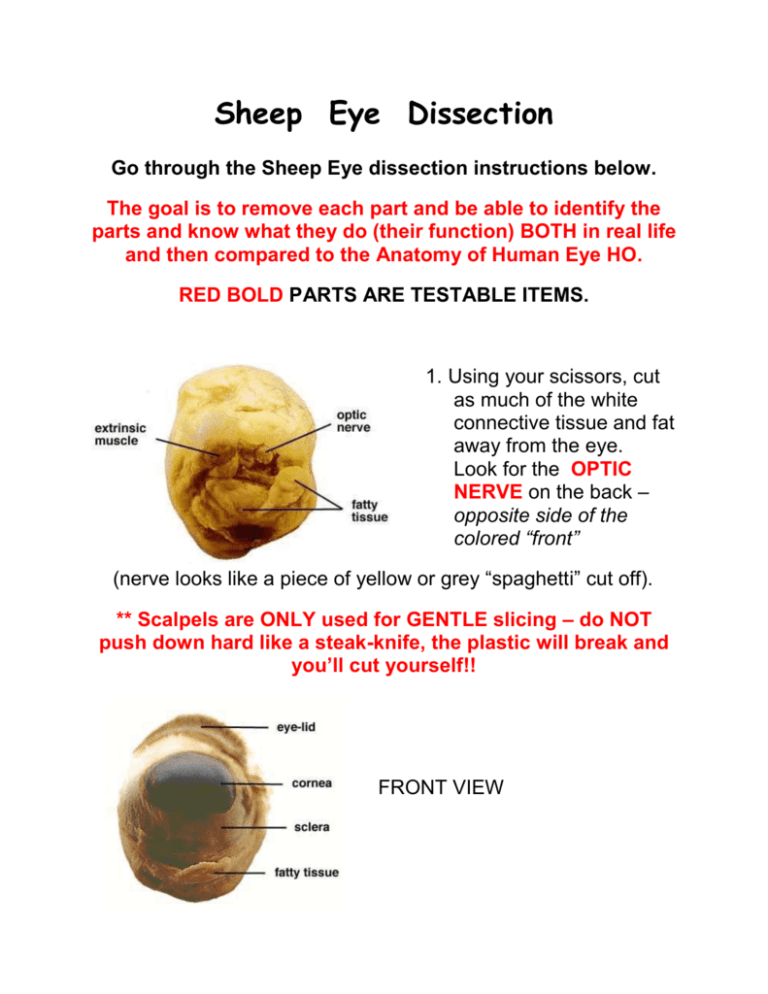Sheep Eye Dissection Guide: Anatomy & Function
advertisement

Sheep Eye Dissection Go through the Sheep Eye dissection instructions below. The goal is to remove each part and be able to identify the parts and know what they do (their function) BOTH in real life and then compared to the Anatomy of Human Eye HO. RED BOLD PARTS ARE TESTABLE ITEMS. 1. Using your scissors, cut as much of the white connective tissue and fat away from the eye. Look for the OPTIC NERVE on the back – opposite side of the colored “front” (nerve looks like a piece of yellow or grey “spaghetti” cut off). ** Scalpels are ONLY used for GENTLE slicing – do NOT push down hard like a steak-knife, the plastic will break and you’ll cut yourself!! FRONT VIEW 2. Using sharp point of scissors (or very carefully the point of the scalpel), puncture the SCLERA so you can cut the eye in half (front half and back half). Be careful, the AQUEOUS HUMOR can sometimes squirt out a bit. You should end up with a front half of the eye and a back half. 3. Look inside the front half of the eye with the LENS in the middle of the jelly-like VITREOUS HUMOR. Remove the LENS and look at the purple feathery muscle below it on the front half of the eye called the IRIS (it controls how big the pupil is to let light into the eye) 4. Try to carefully slice around the IRIS to remove it while leaving the PUPIL intact. It should look like below now. Look at the “front” side of the iris – what color was your sheep’s eyes? Did you also notice anything different about the shape of the sheep’s pupil compared to a human’s pupil? (see answer below) sheep pupil is rectangular - not round like a human 5. Go back to the front half of the eye without the IRIS – you have a “clear” CORNEA surrounded by the white SCLERA. (it’s a bit cloudy because it’s been dead a while and decaying slowly). Look through the cornea to see how much you can see through it. 6. Cut the CORNEA from the SCLERA so it is a separate part. This is a part of the eye that can be transplanted to allow people to see better if they have a disease or damage to their own cornea. Corneas are donated by organ donors. 7. Go back to the LENS with VITREOUS HUMOR around it – the black lines are where ligaments/muscles attach to the LENS to change its shape to focus on things (they have decayed a bit too). Remove the VITREOUS HUMOR from around the LENS - you can then gently bounce the LENS on the table to show it’s somewhat flexible to allow focusing (it’s become more stiff after death) What lens shape does the sheep’s lens have: convex or concave? Since the lens is convex – what will happen to the image when the light rays pass through it? 8. Magnification of the LENS – you can’t put it on some writing to magnify because it’s been dead a while and clouded over. The picture below is of a fresh eye’s lens and shows it magnifies. You should know how convex lenses work from the Focal Length Lab – you get some magnification (but the light rays did not have enough space in the picture above to flip upside down). 9. Now for the back half of the eye The clear/yellowish film is the RETINA a bunch of nerve tissue. Gently peel it away from the purplish choroid behind it. Nerves are very delicate and the retina will probably rip – no problem. Then try to peel the purple choroid away from the white SCLERA in as big a piece as possible – it’s very thin and delicate so go slowly and try not to tear it. The RETINA nerves sense light and send impulses to the brain. The choroid layer is to provide a dark background to absorb light – and the rainbow shiny part is called the tapetum (which glows when light is shown on it – humans do not have one). 10. You should now have all the major parts dissected and on your tray for identification. .. PARTS YOU NEED TO KNOW ARE: 1. CORNEA 3. OPTIC NERVE 5. PUPIL 10. RETINA 4. IRIS 11. LENS CLEANUP: WRAP ALL SHEEP EYE PARTS WELL INSIDE PAPER TOWEL AND DISPOSE BUNDLE IN GARBAGE WITH NO PARTS VISIBLE RINSE OFF ALL INSTRUMENTS AND TRAY AND REPLACE PAPER TOWEL WITH NEW PIECE, PUT INSTRUMENTS ON PAPER IN TRAY AND RETURN TO FRONT TABLE MAKE SURE SINK IS CLEAN WITH NOTHING LEFT IN IT











